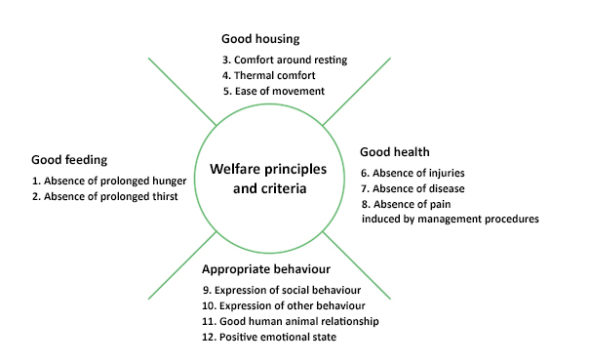Animals are sentient beings whose welfare requirements should be payed full regard to, says the EU Lisbon Treaty. People use animals in many ways, so the responsibility for animal welfare belongs to us all.
Welfare is an animal’s experience of its own psychological and physical state. The state of welfare can vary from good to bad. Welfare is a broad concept, encompassing e.g. physical and mental health, normal growth and, good care for animals under human custody.
Welfare is influenced by the ability of an animal to adapt to environmental events and conditions. If adaptation fails, or causes constant or severe stress, strain, behavioral disorders or ill health to the animal, the welfare of the animal becomes weaker. Animal welfare can be influenced by housing conditions, care, handling and breeding. Humans have bred features on animals that suit us, such as the easy nature of the animal, good production results, and pleasing appearance. Man’s choice is not always a promoter of animal welfare, but the welfare problems caused by animal breeding can also be solved by means of breeding.
Various indicators have been developed to evaluate animal welfare in practical situations. Measures can be used to evaluate animal’s housing conditions or things that are measured straight from the animal, such as the condition of the skin or fur, limping, aggression between animals or animals fear of humans. The evaluation system developed in the Welfare Quality® research project is based on four principles of animal welfare: appropriate behaviour, good health, feeding and housing.
The four principles and 12 criteria that are the basis for the Welfare Quality® farm animal welfare assessment protocols

There is no simple measure for animal welfare. Behaviour is however, in a central role in evaluating animal welfare, as it usually is the first means by which the animal tries to adapt to its environment. Behaviour is the first to change when the animal is subjected to external or internal stressors. Behaviour thus is a sensitive indicator of welfare: more sensitive than e.g. health, production or feed consumption. Health is an important factor in welfare, but welfare is a broader concept than health. Production is insufficient for determining welfare, too, for an extensively bred farm animal can at least on the short term produce efficiently at the cost of its own welfare. The state of an animal’s welfare cannot generally be tasted or seen in the animal product. Animal welfare regulations establish the minimum requirements for animal husbandry and care. Meeting these regulations does not necessarily guarantee the welfare of the animal, however.
For the welfare, it is of paramount importance that the animal has the opportunity to satisfy its most essential behavioral needs. For example the resting time of a dairy cow is shorter on a hard surface compared to a soft one. Thus, a cow’s resting behavior can suggest that a soft resting surface is better for its welfare. Various forms of abnormal behaviour, such as tail biting on pigs, may increase as welfare decreases. Tail biting on pigs is a situation where pigs in a pen bite each other’s tail, causing painful injuries. Some forms of abnormal behaviour can reveal what the animal is suffering from. For example the suckling of other calves by calves may tell of their unsatisfied need for suckling.
Read more about animal welfare at www.elaintieto.fi (in Finnish)
